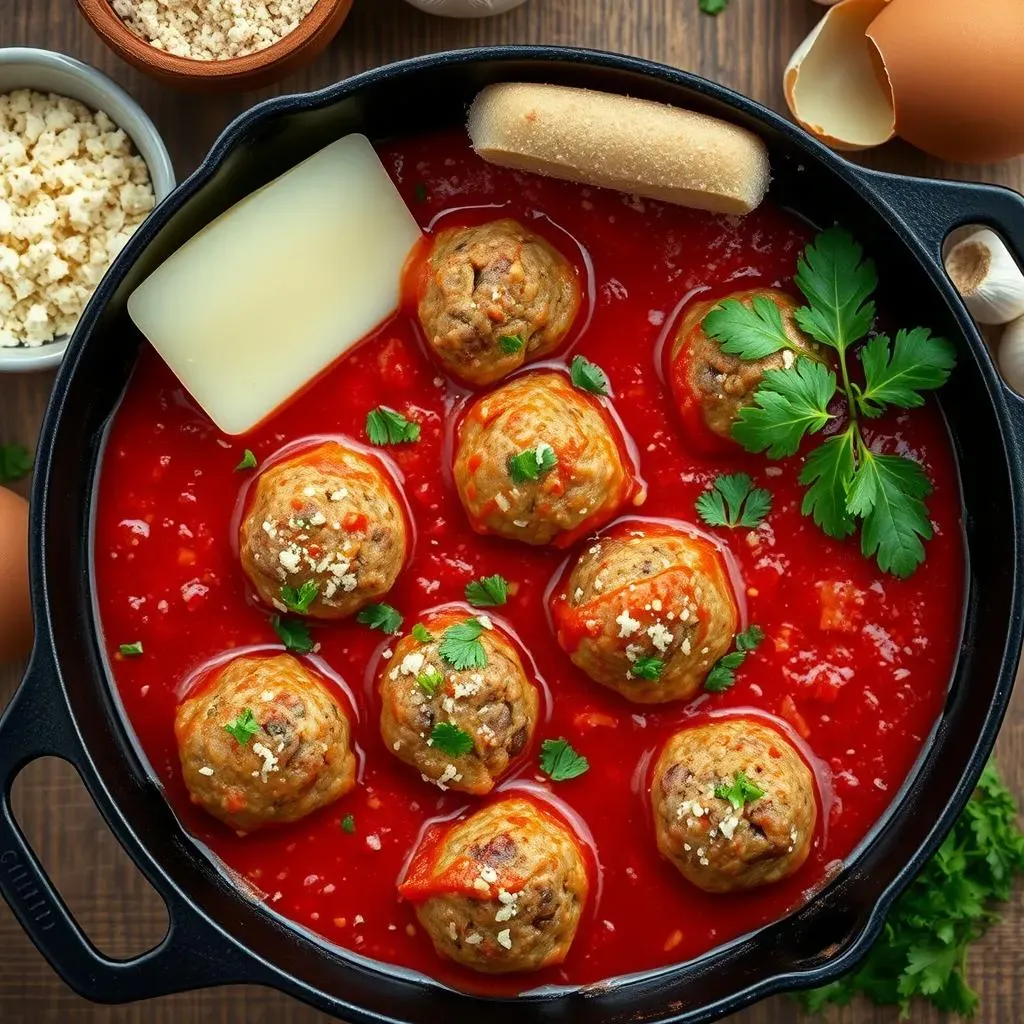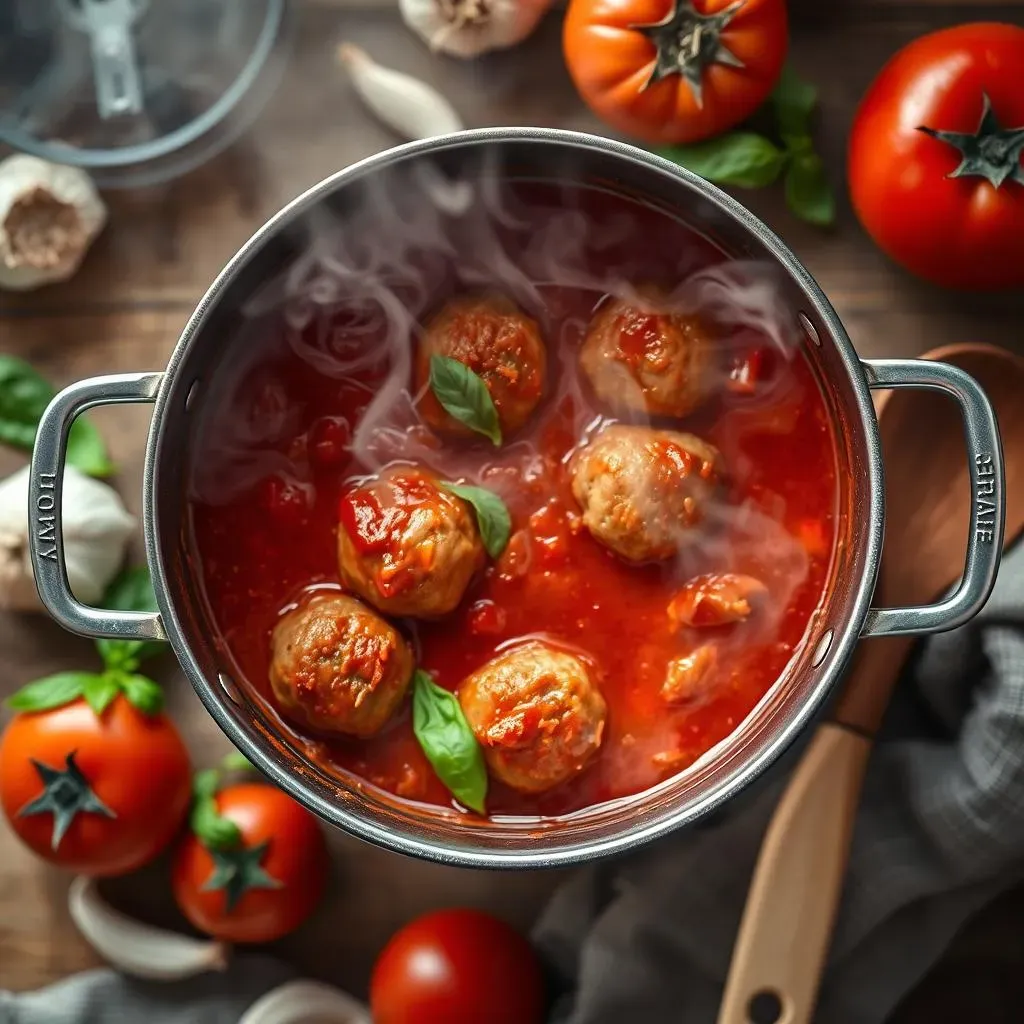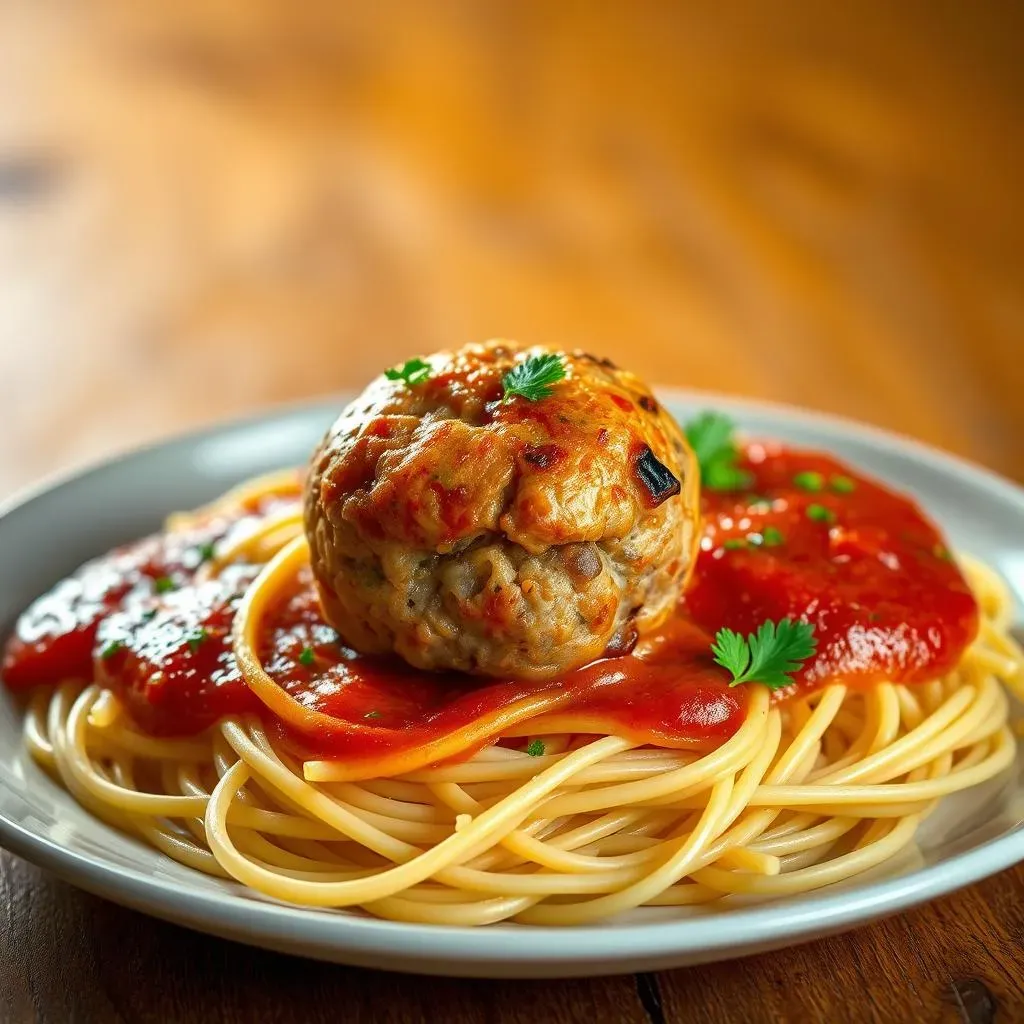Table of Contents
Is there anything more comforting than a big plate of spaghetti and meatballs? Forget the jarred sauce and frozen meatballs, because tonight, we're going all in with a **homemade meatball recipe for spaghetti** that will knock your socks off. This isn't just any recipe; it's a journey into flavor, texture, and the pure joy of creating something delicious from scratch. We'll start by diving into the secrets of perfectly seasoned, tender meatballs, ensuring they're bursting with savory goodness. Then, we'll craft a rich, vibrant tomato sauce that clings lovingly to every strand of spaghetti. Get ready to learn how to combine these elements into a symphony of flavors that will have your family begging for seconds. From choosing the right ingredients to mastering the cooking techniques, we'll cover everything you need to create the ultimate spaghetti and meatballs experience. So, grab your apron, and let's get cooking!
Crafting the Perfect Homemade Meatballs for Spaghetti

Crafting the Perfect Homemade Meatballs for Spaghetti
Choosing Your Ground Meat
Alright, let's talk meat! This is where the magic begins when crafting the perfect homemade meatballs. You've got options, but I'm a big fan of a blend. A mix of ground beef and ground pork gives you the best of both worlds: the beef brings that classic, hearty flavor, while the pork adds moisture and a touch of sweetness. Aim for about 80% lean ground beef – you want some fat for flavor, but not so much that your meatballs are greasy. As for the pork, a regular ground pork works just fine. If you're feeling adventurous, you can even throw in a little ground veal for extra tenderness, but it's not essential.
But hey, if you're not a pork fan, no sweat! All-beef meatballs can be delicious too. Just make sure you don't go too lean with the beef, or they might end up dry. And for those avoiding red meat altogether, ground chicken or turkey can be a surprisingly tasty alternative. Just remember that poultry tends to be drier, so you'll want to add a little extra moisture in the form of breadcrumbs or grated vegetables. Experiment and find what you like best!
Binding It All Together
so you've got your meat, now what? You need something to bind it all together and give your meatballs that perfect, slightly springy texture. That's where breadcrumbs and eggs come in. For the breadcrumbs, I prefer using fresh breadcrumbs made from day-old Italian bread. They're lighter and absorb moisture better than the store-bought kind. Just pulse a few slices of bread in a food processor until you have coarse crumbs. If you only have dry breadcrumbs on hand, that's okay too – just soak them in a little milk or broth before adding them to the meat mixture.
As for the eggs, they act as a glue, holding everything together and adding richness. You'll typically need one or two eggs per pound of meat, depending on the size of your eggs and the consistency of your mixture. Don't overdo it with the eggs, though, or your meatballs might end up rubbery. You also need seasoning! I like to use grated Parmesan cheese, garlic, parsley, salt, pepper, and a pinch of red pepper flakes for a little kick. Mix everything gently with your hands until just combined – be careful not to overmix, or your meatballs will be tough.
Ingredient | Purpose | Notes |
|---|---|---|
Ground Meat (Beef/Pork Blend) | Main flavor and texture | 80% lean beef recommended; pork adds moisture |
Fresh Breadcrumbs | Binder, absorbs moisture | Day-old Italian bread preferred; soak dry breadcrumbs in milk |
Eggs | Binder, adds richness | 1-2 eggs per pound of meat |
Parmesan Cheese | Flavor, adds saltiness | Grated Parmesan is best |
Garlic, Parsley, Seasoning | Adds flavor | Minced garlic, fresh parsley, salt, pepper, red pepper flakes (optional) |
Making a Rich Tomato Sauce for Your Spaghetti and Meatballs

Making a Rich Tomato Sauce for Your Spaghetti and Meatballs
The Tomato Base: Fresh vs. Canned
Let's get saucy! When it comes to **making a rich tomato sauce for your spaghetti and meatballs**, the foundation is, well, the tomatoes! You've got a choice to make: fresh or canned. Now, if it's summertime and you've got access to ripe, juicy tomatoes from your garden or a local farmer's market, by all means, go fresh! Roasting them first will deepen their flavor and bring out their natural sweetness. Just core them, toss them with olive oil, salt, and pepper, and roast at 400°F (200°C) until they're softened and slightly caramelized. Then, you can peel them (if you want, but it's not essential), and crush them by hand or in a food mill.
However, let's be real: most of the year, canned tomatoes are the way to go. Look for high-quality, whole peeled tomatoes packed in juice. San Marzano tomatoes are widely considered the best, but any good brand will do. You can also use crushed tomatoes or tomato puree, but I find that whole tomatoes give you more control over the texture of the sauce. Just crush them by hand or with a potato masher as they cook. Avoid using tomato paste as the base of your sauce, as it can be too concentrated and acidic.
Building the Flavor: Aromatics and Herbs
Alright, you've got your tomato base, now it's time to build some flavor! This is where the aromatics come in: onions, garlic, and maybe even some carrots and celery (a classic mirepoix). Start by sautéing the onions in olive oil over medium heat until they're softened and translucent. Then, add the garlic and cook for another minute or two, until fragrant. Be careful not to burn the garlic, or it will turn bitter. If you're using carrots and celery, add them along with the onions and cook until softened.
Next, it's time for the herbs! Fresh herbs are always best, but dried herbs work in a pinch. I like to use a combination of basil, oregano, and thyme. Add the dried herbs along with the garlic, and the fresh herbs towards the end of cooking. You can also add a bay leaf for extra flavor. And don't forget the seasoning! Salt, pepper, and a pinch of red pepper flakes are essential. You can also add a little sugar to balance the acidity of the tomatoes, but it's not always necessary.
Ingredient | Purpose | Notes |
|---|---|---|
Onions, Garlic | Aromatics, build flavor | Sautéed in olive oil until softened |
Carrots, Celery (optional) | Adds sweetness and depth | Cooked with onions and garlic |
Basil, Oregano, Thyme | Herbs, adds flavor | Fresh or dried; add fresh herbs at the end |
Bay Leaf | Adds subtle flavor | Remove before serving |
Salt, Pepper, Red Pepper Flakes | Seasoning | Adjust to taste; sugar optional |
Simmering to Perfection
So you've got your tomato base, your aromatics, and your herbs. Now it's time to let it all simmer together and meld into a beautiful, rich sauce. Add the tomatoes to the pot and bring to a simmer. Then, reduce the heat to low, cover, and let it simmer for at least 30 minutes, or even longer for a deeper flavor. The longer it simmers, the more the flavors will develop and the sauce will thicken. Stir occasionally to prevent sticking.
If you want to add some extra richness to your sauce, you can stir in a little butter or olive oil towards the end of cooking. You can also add a splash of red wine for extra depth of flavor. Just make sure to let the wine simmer for a few minutes to cook off the alcohol before adding the meatballs. And speaking of meatballs, now's the time to add them to the sauce! Gently nestle the meatballs into the sauce and let them simmer for another 30 minutes, or until they're cooked through and the sauce has thickened even more. Serve over your favorite spaghetti and enjoy!
StepbyStep Guide: Combining Meatballs, Sauce, and Spaghetti

StepbyStep Guide: Combining Meatballs, Sauce, and Spaghetti
Cooking the Spaghetti to Perfection
Alright, the meatballs are simmering in the sauce, and the aroma is driving you crazy, right? Now, it's time to cook the spaghetti. This might seem straightforward, but there are a few tricks to ensure pasta perfection. First, use a large pot with plenty of water – at least 6 quarts for a pound of spaghetti. Generously salt the water – it should taste like the sea! This seasons the pasta from the inside out. Bring the water to a rolling boil, then add the spaghetti. Stir it immediately to prevent sticking.
Cook the spaghetti according to the package directions, but subtract about a minute or two. You want it to be al dente, which means "to the tooth" in Italian. It should be firm and slightly resistant when you bite into it. Before you drain the spaghetti, reserve about a cup of the pasta water. This starchy water is liquid gold! You can use it to thin out the sauce if it's too thick, or to help the sauce cling to the pasta. Drain the spaghetti in a colander, but don't rinse it – you want to keep that starchy coating.
The Grand Finale: Combining Everything
Now for the best part: combining the spaghetti, sauce, and meatballs! There are a couple of ways to do this. You can either toss the spaghetti directly into the pot with the sauce and meatballs, or you can plate the spaghetti and top it with the sauce and meatballs. I prefer the first method, as it allows the spaghetti to absorb more of the sauce and flavor. Just add the drained spaghetti to the pot and toss gently to coat. If the sauce is too thick, add a little of the reserved pasta water until it reaches your desired consistency.
Serve immediately, topped with plenty of grated Parmesan cheese and a sprinkle of fresh parsley. And don't forget some crusty bread for soaking up all that delicious sauce! This homemade meatball recipe for spaghetti is a labor of love, but trust me, it's worth every minute. Enjoy!
Step | Description | Notes |
|---|---|---|
Cook Spaghetti | Boil in salted water until al dente | Reserve pasta water before draining |
Combine | Toss spaghetti with sauce and meatballs | Add pasta water to adjust consistency |
Serve | Top with Parmesan and parsley | Enjoy with crusty bread |
Tips & Tricks for the Best Homemade Meatball Spaghetti Recipe

Tips & Tricks for the Best Homemade Meatball Spaghetti Recipe
Meatball Mastery: Achieving Tenderness and Flavor
So, you're aiming for meatball perfection, huh? Let's dive into some **tips & tricks for the best homemade meatball spaghetti recipe**, focusing on tenderness and flavor. First off, don't overwork the meat! Overmixing develops the gluten in the meat, resulting in tough, dense meatballs. Mix gently with your hands until just combined. Another key is to keep the mixture cold. Chilling the meat mixture for about 30 minutes before rolling the meatballs helps the fat solidify, preventing them from spreading out too much during cooking. Also, consider adding a secret ingredient. Some folks swear by a splash of Worcestershire sauce or a pinch of nutmeg for an extra layer of flavor. Don't be afraid to experiment!
To ensure even cooking, make sure your meatballs are uniform in size. A cookie scoop can be helpful for this. When browning the meatballs, don't overcrowd the pan. Work in batches to ensure they get a nice sear on all sides. This not only adds flavor but also helps them hold their shape during simmering. Speaking of simmering, don't boil the meatballs in the sauce. A gentle simmer is all you need to cook them through without making them tough. And finally, resist the urge to stir the meatballs too much while they're simmering. Let them develop a nice crust on the bottom before gently turning them.
Sauce Secrets: Enhancing Richness and Depth
Now, let's talk sauce. A truly great spaghetti and meatballs dish hinges on a flavorful, well-developed sauce. One of the best **tips & tricks for the best homemade meatball spaghetti recipe** is to start with good-quality ingredients. Use high-quality canned tomatoes or, even better, fresh, ripe tomatoes when they're in season. Roasting the tomatoes before making the sauce intensifies their flavor and adds a touch of sweetness. Another secret is to build the flavor in layers. Start by sautéing the aromatics (onions, garlic, carrots, celery) in olive oil until they're softened and fragrant. Then, add the tomatoes and let them simmer for at least 30 minutes, or even longer for a richer flavor.
Don't be shy with the herbs and spices! A generous pinch of dried oregano, basil, and thyme adds depth and complexity to the sauce. You can also add a bay leaf for extra flavor, but be sure to remove it before serving. A splash of red wine can also elevate the sauce, adding a subtle fruity note. Just make sure to let the wine simmer for a few minutes to cook off the alcohol before adding the tomatoes. And finally, don't forget to season the sauce properly. Salt, pepper, and a pinch of red pepper flakes are essential. You can also add a little sugar to balance the acidity of the tomatoes, but it's not always necessary.
Tip | Description | Benefit |
|---|---|---|
Don't Overwork Meat | Mix gently until just combined | Tender meatballs |
Chill Meat Mixture | Chill for 30 minutes before rolling | Helps fat solidify, prevents spreading |
Good Quality Tomatoes | Good quality canned tomatoes or fresh tomatoes | Better flavor |
Build Flavors | Sauté aromatics and add herbs | Depth and complexity |
Simmer | Simmer the sauce for a minimum of 30 minutes | Flavor development |
Serving Suggestions: Plating and Garnishing
Presentation matters! Even the most delicious spaghetti and meatballs can be elevated with a few simple plating and garnishing **tips & tricks for the best homemade meatball spaghetti recipe**. First, cook the spaghetti al dente. Overcooked, mushy spaghetti is a cardinal sin! Drain the spaghetti well, but don't rinse it. The starchy water helps the sauce cling to the pasta. Toss the spaghetti with the sauce and meatballs in a large bowl or pot, ensuring that every strand is coated with flavor. Then, twirl the spaghetti onto plates or bowls, creating a neat and appealing presentation.
Top with a generous amount of grated Parmesan cheese and a sprinkle of fresh parsley. You can also add a drizzle of olive oil for extra richness and shine. For a more rustic presentation, serve the spaghetti and meatballs in a large, family-style bowl, allowing everyone to help themselves. And don't forget the sides! Crusty bread for soaking up the sauce is a must. A simple green salad or Caesar salad provides a refreshing contrast to the rich and savory spaghetti and meatballs. And finally, a glass of red wine is the perfect accompaniment to this classic Italian dish.
Savoring the Simplicity: Your Homemade Meatball Spaghetti Triumph
There you have it – a complete guide to creating a truly memorable spaghetti and meatballs dish from scratch. This **homemade meatball recipe for spaghetti** isn't just about following instructions; it's about embracing the process, experimenting with flavors, and sharing the joy of a home-cooked meal with loved ones. Don't be afraid to tweak the recipe to your liking, add your own special touch, and most importantly, enjoy every bite. After all, the best meals are the ones made with love and shared with good company. So, gather around the table, twirl some spaghetti, and savor the deliciousness of your homemade creation. Until next time, happy cooking!